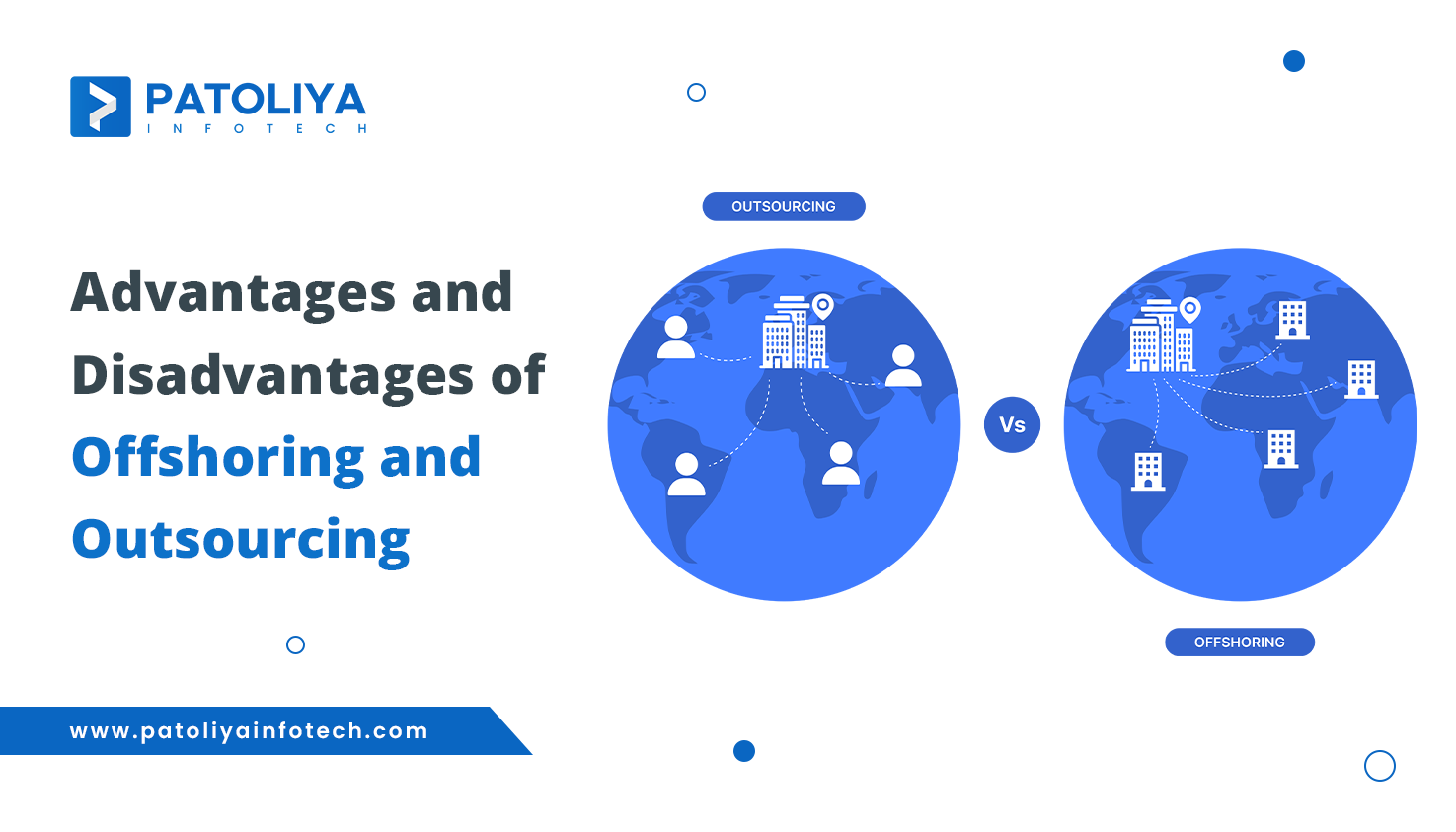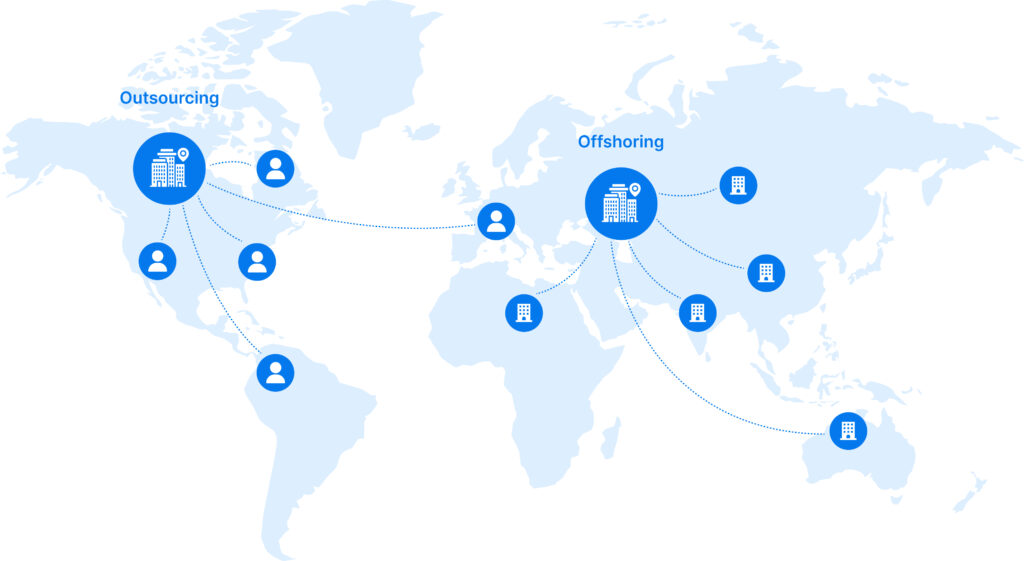What are the main differences between offshoring and outsourcing?

Table of Contents
Companies are constantly looking for ways to improve efficiency, save costs and increase productivity in our connected world. Offshoring and outsourcing are two popular solutions that are constantly explored. Although initially similar, each has different functions and specific advantages and disadvantages. So let’s set out to discover these two ways.
Curious about how IT Solution Providers will shape the next era of technology? Dive into our in-depth exploration
What is Offshoring?
What is Outsourcing?
Why Companies Outsource and Offshore?
- Cost Reduction:
- Lower Labor Costs: Companies can profit from lower wages in various locations by implementing both tactics.
- Access to Specialized Skills:
- Expertise: Businesses can access a worldwide talent pool full of people with specialized knowledge and skills.
- Innovation: Innovation and advancement can be stimulated by exposure to different markets and concepts.
- Scalability and Flexibility:
- Adaptability: Effortlessly adjust your business to meet demand without making huge financial commitments.
- Focus: By outsourcing non-essential jobs to others, businesses may focus on their most important skills.
Offshoring vs Outsourcing - Advantages and Disadvantages

Advantages of Offshoring
- Cost Savings:
- Labor Costs: The labor cost decrease is one of the biggest benefits. When compared to Western nations, competent labor is available at a significantly lower cost in places like India, China, and the Philippines.
- Operational Costs: Total cost reductions are additionally affected by lower operating costs for things like rent, utilities, and taxes.
- Access to a Global Talent Pool:
- Specialized Skills: Through offshoring, companies can access a wide range of skilled workers with specialized knowledge that would not be easily found domestically.
- Innovation: Being exposed to many markets and cultures can inspire creative thinking and solve problems.
- Scalability and Flexibility:
- Expansion: Without the large capital expenditures necessary for domestic expansion, businesses can simply scale up or down operations in response to market demands.
- 24/7 Operations: Operating around the clock is made possible by several time zones, which boosts output and customer care.
Disadvantages of Offshoring
- Communication Barriers:
- Language: Misunderstandings and mistakes may result from variations in language and communication techniques.
- Time Zones: It might be difficult to coordinate across time zones and may need modifying work schedules.
- Quality Control Issues:
- Standards: Ensuring that offshore activities meet the same quality requirements as those conducted domestically might present challenges.
- Oversight: Lack of management may result in operational inefficiencies and quality failures.
- Cultural Differences:
- Work Culture: Workplace collaboration and productivity can be affected by differences in corporate culture and procedures.
- Integration: There may be a negative impact on team dynamics when integrating offshore and domestic teams.
Not sure which offshore or nearshore development is best for you? Let's explore it and identify the best answer for the particular requirements of your business!
Advantages of Outsourcing
- Focus on Core Business Activities:
- Efficiency: Organizations can focus on their main skills and experience increased productivity by outsourcing non-essential operations.
- Expertise: Partners in outsourcing frequently provide specialized knowledge and technology, which raises the standard of services overall.
- Cost Reduction:
- Variable Costs: Better financial flexibility is made possible by outsourcing, which changes fixed costs into variable costs.
- Economies of Scale: The cost advantages that outsourcing providers pass on to their clients are generally realized through larger-scale operations.
- Speed and Flexibility:
- Quick Implementation: Resources and solutions that would take significantly longer to create internally can be obtained more quickly through outsourcing.
- Adaptability: Businesses don't have to worry about making long-term commitments, so they can quickly adjust to market developments.
Disadvantages of Outsourcing
- Loss of Control:
- Oversight: Management of quality and performance may become more difficult if outsourcing results in a loss of control over specific business operations.
- Dependency: If an external vendor doesn't perform up to the same, there may be risks associated with spending too much on them.
- Security Risks:
- Data Protection: Sensitive information sharing with outside suppliers might make data breaches and intellectual property theft more likely.
- Compliance: Maintaining dedication to legal and regulatory requirements may create greater challenges when collaborating with other parties.
- Potential for Hidden Costs:
- Contracts: The projected savings may be undermined by unforeseen expenses for contract administration, transfer, and vendor management.
- Misalignment: When the company and the organization have different expectations and goals, it can cause delays and extra expenses.
The Key Differences:
| Feature | Outsourcing | Offshoring |
| Location | Domestic | International |
| Control | More control over project execution | Less direct control, relies on partner |
| Cost Savings | Moderate cost savings | Potentially higher cost savings |
| Expertise | Access to specialized skills | May require cultural training for overseas teams |
Don't make a decision without knowing these critical points! Ensure your IT solution provider is the perfect match for your business needs.
Key Differences Between Outsourcing and Offshoring

- Location:
- Outsourcing: Can occur domestically or internationally.
- Offshoring: Always involves an international relocation of services.
- Control:
- Outsourcing: Generally less control over the outsourced functions due to reliance on third-party vendors.
- Offshoring: More control over processes as operations are typically managed by the company itself, albeit in a different country.
- Objective:
- Outsourcing: Aimed at leveraging external expertise and reducing operational burden.
- Offshoring: Primarily focused on reducing costs through geographic relocation.
Outsourcing vs. Offshoring: When to Use?
- Outsourcing:
- Suitable for non-core tasks like IT support, customer care, and payroll.
- Excellent for locating specialized knowledge that cannot be found within.
- Perfect for projects where project implementation requires speed and flexibility.
- Offshoring:
- Excellent for high-cost processes like software development and manufacturing.
- Adequate for situations requiring 24/7 access to specialized skills.
- Excellent for lengthy projects where the business wants to keep process control.
Conclusion
There are several advantages to outsourcing and offshoring, such as lower costs, easier access to specialized expertise, and more flexibility. They do, however, also present difficulties such as dangers to security, poor quality control, and communication obstacles.
To optimize the benefits while minimizing the drawbacks of these techniques, businesses must carefully assess their needs, carry out in-depth research, and implement sound management practices. By doing this, businesses would be able to fully utilize outsourcing and offshoring to boost their competitiveness and growth in the global market.



